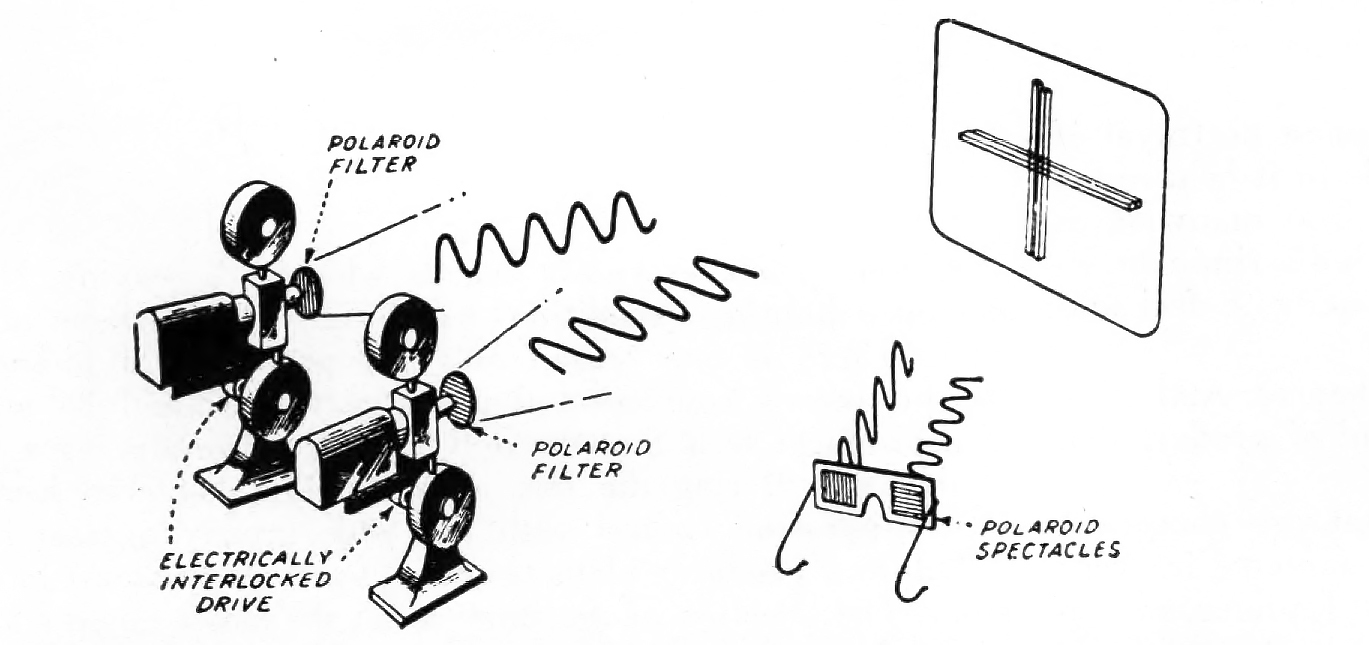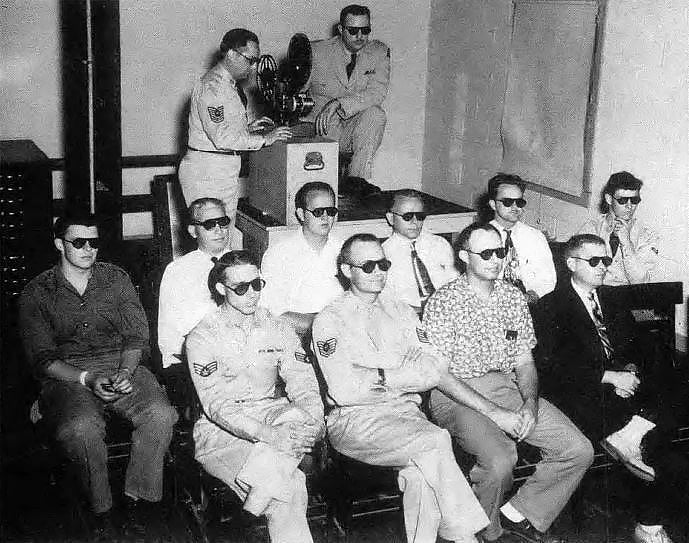
Stereoscopic Motion Pictures - Part 2
Success of entertainment three-dimensional films is dependent on quality of the screen image.

By J. A. Norling, President, Loucks & Norling Studios, New York, N.Y.
Continued from the previously published Part 1...
It has always been the writer’s opinion that the stereoscopic camera for professional use should be built to take the images on two separate films. This is to afford the greatest flexibility in the studio and to permit the use of short focus lenses and to facilitate the making of optical effects in the duplicating processes.

One such camera was built. It contains the features deemed essential to a versatile camera. The most important are a variable interaxial and a convergence control, but important too is a binocular finder showing in miniature a three-dimensional view of the scene to be photographed. Visual inspection during focusing seems superior for stereoscopic work and focusing is easier when the view is seen in three dimensions.
The binocular view finder has an additional advantage: it enables the cameraman to compose the scene stereoscopically, using the interaxial and convergence controls, manipulating them until he gets the best possible arrangement. He can increase the interaxial if he wants to increase the apparent depth of the scene. He can reduce it if nearby objects demand it.
The dual projector system used at the New York and San Francisco Fairs is substantially the same as that which was on exhibition at the Festival of Britain. According to press reports, it is also the same system which has been demonstrated by Natural Vision Corp. of Hollywood.
Systems for stereoscopic films using dual images side-by-side or one above the other have also been proposed. One of the problems in the two-image arrangement, whether in tandem or side by side, is the loss of light, because the light-covering circle covers a large area around the area occupied by the two images.
The ordinary circular light spot from the projector arc spills light all around the images. This condition can be improved upon by a light condensing system having a cylindrical lens element. Then the light spot becomes oval instead of round.
Another method is to introduce an optical device on the camera to compress the images in one direction, and a similar device on the projector to expand them back to normal proportions. Such an optical device is called an “anamorphoser.” Several types have been constructed, but it remained for Dr. H. Sidney Newcomer to design one that does not introduce serious aberrations and have other optical handicaps. The Newcomer Anamorphoser is capable of effecting a compression of the image to almost ⅔ and an expansion of about 1½ times.
Among the methods suggested for the employment of a single film to carry the two images is the “beam-splitter” in one form or another. The device has two pairs of mirrors placed in front of the lens and arranged so that the pair on the left will cause the left-eye image to be selected for projection to the screen and the right-hand pair will do the same for the right-eye image.
The beam-splitter is a device that does exactly what its name implies — it splits the light beam into two parts. Hence, the intensity of each part cannot be greater than half of the whole beam. It is a simple device and easy to use.
But in addition to light loss, it has another drawback. The pictures overlap considerably, making it impossible to mask them to a stereoscopic window. The window must be artificially produced by a black border on the screen, usually of velvet, to absorb spill-over light. Another shortcoming: The camera lens works at something less than half the F stop setting shown on the lens. This means more than twice the amount of light required for conventional photography.
When it comes to shooting interiors, this added light requirement proves to be an economic disadvantage of the beam splitter method. There is a corresponding light loss in projection, and here the loss is even more significant. Take the loss inherent in the beam-splitter, add that to the loss in polarization, and you find that you’re getting about 1/12th the light that you had when you projected the full frame in the conventional way.
Another disadvantage of the beam-splitter is the picture proportions it gives — a narrow and tall picture, certainly inappropriate for stereoscopic representation which is so well suited for panoramic views.
Another proposed device has dual lenses producing square pictures side by side. There is no light loss in the camera, since two lenses are used and the window for each picture is quite sharp. However, there is considerable loss in projection if the attachment is used on a projector not provided with a special condenser system. If the standard proportions are retained, each image is less than one-fourth the area of the full frame.

Another method which has been proposed for simultaneous projection, is the arrangement of images with one member above the other. Special projectors would be required. From time to time, the alternate projection of the members of a stereo pair has also been proposed. In this system, the right eye image, for instance, is projected first, then the shutter interrupts the light beam while the film moves down to position the left eye image. Thus there are periods of flicker that occur at different times for each eye.
If we break this sequence of events down, we find that the first light period has a value of 12.5% of the complete picture cycle. The flicker blade on the projector shutter (considering a two-bladed shutter) gives a dark period lasting 12.5% to be followed by a light period of the same, then a long dark period consuming 62.5% for pull-down and eclipse to permit the other eye to see its image.
If standard sound-film speed of 24 frames a second is used, the resulting flicker is very annoying. Stepping up the projection to 48 frames a second increases flicker frequency twice, but it still is noticeable.
There is a physiological effect that is likely to become disagreeably apparent — usually headache or nausea — after a few minutes of viewing pictures projected in this way. A complete period of darkness for one eye, while light reaches the other, will probably always result in visual fatigue, if not in nausea, no matter how high, within workable limits, the flicker frequency is brought.
Flicker of low frequency calls for traction on the control muscles of the irises when bright light enters one or both eyes. The rapid occurrence of the transmission of stimuli, first from one eye, then from the other, and the motor messages from the brain to the muscles, delivered in rapid sequence, probably accounts, in part, for the visual discomfort experienced by most people when viewing “eclipse” stereo movies.
Perception of flicker depends upon the intensity of the interrupted light, as well as the flicker frequency. The more intense the light, the higher the frequency must go before flicker fusion is attained. Also, the larger the angular field over which flicker is distributed, the greater the consciousness of flicker. Hence the dimmer the picture and the smaller it is, the lower becomes the flicker fusion frequency.
There are two ways to project and view eclipse stereograms. One is by using rotating or vibrating shutter devices held up in front of the eyes. These are synchronized electrically with the projector. The other method is to employ a rotating polarizer in front of the projector lens and polarizing spectacles for the viewer. In one position the polarizer delivers light through the left spectacle filter, in the other through the right filter.

of the audience wear special viewing spectacles. In above photo, a group is shown watching a
screening of 3-D movies made by Major Robert V. Bernier, whose system was
described in the August, 1951, American Cinematographer. The glasses, plus the barrel polarizer
on projector, enable right and left eyes of audience to see the correct left and right pictures
as they are screened. (Photo courtesy TPSS, Wright Air Dev. Center)
Alternate frame, or eclipse, projection must have twice the number of frames required for conventional films. That means doubling the length and providing for faster projection speed.
If the alternate frames are photographed alternately, there is a very objectionable fringing in pictures of moving objects. This is a cause of eyestrain, especially in a picture where the action seen by one eye is in quite a different stage of progress than the action seen by the other. Difficulty in fusion invariably results. This combination of disturbing effects caused by flickers out of phase between the eyes and by fusion trouble, limits the appreciation of the eclipse method.
Complete visual comfort can be attained in stereo movies only if the two images are projected simultaneously, if they are rock steady, if they are of equal brightness, if they are of equal contrast, if they are properly aligned vertically and horizontally, if far distant points are not separated too far in one image from that of the other, and if they are of exactly the same size.






